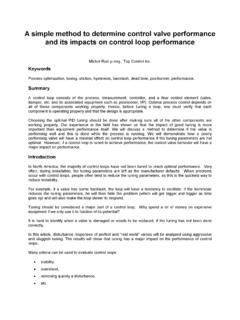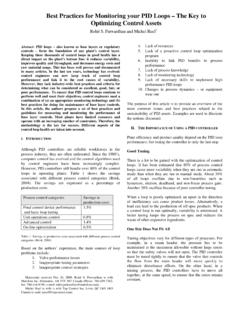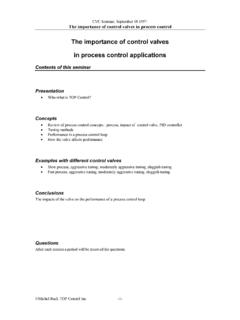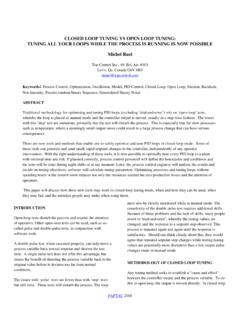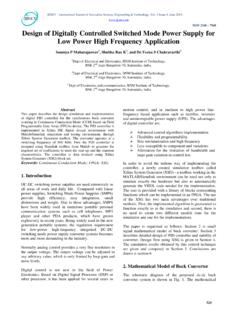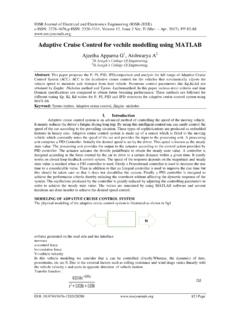Transcription of FAST METHODS FOR SLOW LOOPS: TUNE YOUR …
1 Copyright 2003 by ISA-The Instrumentation, Systems and Automation Society. Presented at ISA EXPO 2003, 21-23 October 2003 in Houston, TX; fast METHODS FOR slow loops : TUNE YOUR TEMPERATURE CONTROLS IN 15 MINUTES Michel Ruel President, TOP Control Inc 4734 Sonseeahray Drive Hubertus, WI 53033 49, Bel-Air St, #103 Levis Qc G6W 6K9 USA Canada KEYWORDS Process control, loop tuning, PID controller, temperature, process modeling. ABSTRACT Traditional METHODS for slow loops PID tuning require several hours, or sometimes days to complete, because they rely on steady-state process response or on continued oscillation. Furthermore, making such a bump can be a major upset to the process, resulting in scrap product and wasted energy.
2 This paper presents METHODS to tune long, slow control loops quickly: in minutes, not hours. INTRODUCTION With traditional METHODS there is way too much emphasis on the large time constant found in most temperature processes. This paper will demonstrate that this can be overcome by focusing on the short-term dynamics of the process. Also, an automated frequency-response tuning method will be demonstrated. Simulations will be used to confirm tuning and expected robustness without upsetting the process. The new tuning will perform better for both, load upsets and set-point changes, resulting in tighter temperature control, reduced oscillation, and fastest response. TRADITIONAL METHODS TO TUNE TEMPERATURE loops Traditional METHODS to tune loops and find a model for them have been known for decades.
3 It can be done by hand or using a tuning software package. METHOD First step is to ensure that all the equipment is working properly. Second step is to stabilize the process, then bump the controller output and let the process stabilize again. It is preferable to repeat the bump in the opposite direction since many processes behave differently according to the direction. The third step consists to determine the process model then compute tuning parameters considering : set-point response or load response Copyright 2003 by ISA-The Instrumentation, Systems and Automation Society. Presented at ISA EXPO 2003, 21-23 October 2003 in Houston, TX; performance criterion selected controller structure and units.
4 For example, a temperature process with a long time constant is used to compare tuning and identification method. This method is time consuming and if an upset happens during the test, it will have to be redone. Also, during the test, the loop is not in automatic mode and it could be impossible to do. Figure. 1 Bump test in manual mode The model identified for this process is : Figure. 2 Real process and model, bump test The test lasted 3 hours before reaching a steady state. The model found matches closely the real process for the first part. At the end, the model differs since the real process is of higher order. To tune the loop or to determine the model, this test is perfect. The process model is usually found using fitting curves techniques.
5 Another technique uses Fourrier transform then analyzes the data in the frequency domain. The software determines which model will produce the best fit : first order + dead time, second order + dead time, integrating + dead time, .. Real process Model Copyright 2003 by ISA-The Instrumentation, Systems and Automation Society. Presented at ISA EXPO 2003, 21-23 October 2003 in Houston, TX; This method where the analysis is done in the frequency domain is at the origin of the following method. Any signal producing low frequencies (stable) and high frequencies ( fast change) will give good results. NEW METHOD PROPOSED The new method is based not on a bump test but on a short pulse test.
6 This pulse test can be applied on the controller output or on the set-point if the actual tuning parameters can stabilize the loop. This method is quick, includes dynamics when increasing and decreasing. We assume the equipment has been verified or tested before. First step is to stabilize the process then bump the controller output (or the set-point) and wait enough time to see the process variable change by a sufficient amount; a sufficient amount is usually 3 to 5 times more than the noise band. In manual mode, note the time that the controller output had to be maintained to observe a sufficient change and bump the controller output in the opposite direction by twice the first change. Maintain the controller output at this value during the same time it was initially; finally go back to the original value.
7 CO SP Manual mode pulse test t (s)t (s)Automatic mode pulse test Figure. 3 Pulse tests in manual and automatic mode In automatic mode, bring back the set-point value at its original value. Using this pulse test, the software can now determine: a process model tuning parameters accordingly to a performance criterion performances expected simulation of different tuning parameters The third step consists to determine the process model then compute tuning parameters considered. An example is presented using the same process. Copyright 2003 by ISA-The Instrumentation, Systems and Automation Society. Presented at ISA EXPO 2003, 21-23 October 2003 in Houston, TX; Figure. 4 Pulse test in automatic mode A short pulse is applied on the set-point change.
8 After 15 minutes, the process is fairly stable. This data is feed to the software which determines the process model and the tuning parameters. Figure. 5 Real process and model, pulse test in automatic mode A similar procedure was used to find the process model using a double pulse test in a manual mode. Figure. 6 Real process and model, double pulse test in manual mode Real process Model Model and processCopyright 2003 by ISA-The Instrumentation, Systems and Automation Society. Presented at ISA EXPO 2003, 21-23 October 2003 in Houston, TX; MODEL IDENTIFICATION For process identification, this method gives quick results and do not disturb too much the process. This is useful to calculate mass balance, uses model predictive control, and multivariable controls.
9 Both METHODS give similar results but the pulse test is a lot quicker. Bump test lasts 3 hours Pulse test lasts 15 minutes Double pulse test lasts 12 minutes Figure. 7 Comparison of METHODS . The results are slightly different but the differences are acceptable. The tuning parameters in each case are similar for the same criterion (tuning for load rejection). CONCLUSION A fast method to tune slow loops has been presented. It is also possible to use this method to determine the process model. This method gives excellent results and can be applied on most processes. Advantages of this method: Quick, reliable, easy to do Can be done in manual or automatic mode Reduce the risk of having load change during the tests Can be done during normal production while the process is running With the model found, it is possible to test control strategies and tuning parameters off-line Tests are used to find process problems, valve problems as well as to calculate tuning parameters.
10 CREDITS All the figures in this article were derived from ExperTune software from ExperTune Inc.
